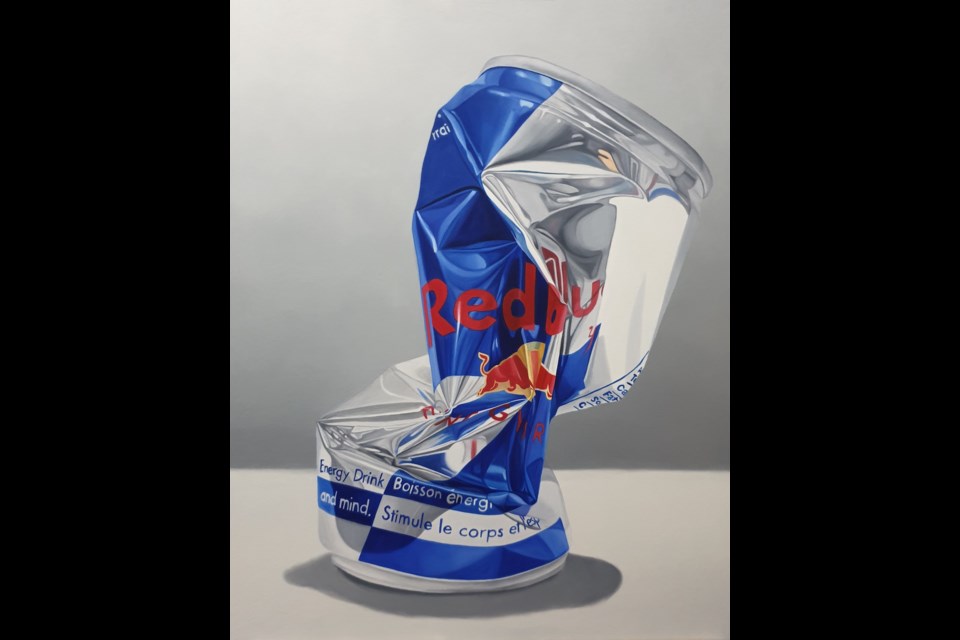Jeongmin Ahn finds trash beautiful. He realized this when he was a student at Emily Carr University of Art and Design, specializing in painting.
“I used to drink a lot of Red Bull during my university days to stay up all night and paint,” he recalled.
During one such night, he thought to himself, “The can of Red Bull is actually beautiful.”
So he crushed a few and painted them. “Of course, because I drank them, they didn’t hold any value anymore. I could have just easily tossed them in the garbage.”
But Ahn didn’t.
In fact, that Red Bull can has prompted him to see trash differently ever since. “That was the initial point.”
Making hyperrealistic paintings of garbage
From there, Vancouver-based Ahn started paying more attention to objects such as plastic bags, bottle lids, cans and more — things that are tossed out without a second thought after their use, he noted.
“With garbage, it’s more like 'out of sight, out of mind.'”
Not for Ahn, though. All trash pieces that he comes across on a day-to-day basis get his complete attention.
Some even end up as artworks on large 24x30 inch canvases.
The artist spends anywhere between two weeks and three months, 12 hours a day, trying to create hyperrealistic paintings of trash. "Sometimes I don't even know where the time goes."
In the end, the painting looks so real that Ahn has had people confuse it for a photograph.
“Every now and then, I hear people go: ‘Oh my God, is that a painting?’ I have to zoom into my images to show them that those are actual paintings,” said Ahn, who also trained with hyperrealist painters in Korea before pursuing a bachelor of fine arts degree at Emily Carr.
The painting of the crushed Red Bull can took the longest — three months. The effort earned him the 2019 Richard Alm Scholar Award from the Federation of Canadian Artists.
Creating artwork that reflects on consumerism
Ahn usually gets ideas for his paintings from visits to grocery stores. When he sees something “wasteful," like a comb of bananas wrapped in plastic, he jots it down in his sketchbook, comes back home and recreates what he saw at the store.
It's then photographed, Photoshopped and painted on a canvas.
Transforming pieces of trash into beautiful oil paintings is only part of the process; what Ahn wants is to provoke a conversation around consumerism and its consequences.
According to the United Nations Environment Program (UNEP), about 11.2 billion tonnes of solid waste are collected worldwide, contributing to five per cent of greenhouse gas emissions. If not disposed of well, the waste can contaminate air, water and soil.
A top solution is to minimize consumption, per UNEP, and Ahn's art is a launchpad to having this conversation.
What pushed him into thinking about consumerism and ecosystem are his years in Bangladesh. Born in Korea, Ahn moved to Bangladesh at the age of 12 and did his middle school and high school there.
“In Asia, in general, we do not recycle properly. So you’ll see plastic bags and garbage thrown around on the streets, in a bunch of countries.”
He recalled, “Nobody gave a second thought about it [garbage], we just tossed it out. And it was not a problem.”
It bothers him that no one seems to care where the garbage even goes. “We just know that it goes to a landfill, but that's about it.”
He hopes to change that with his art; he hopes to have people think: does that comb of bananas really need a plastic wrap?
Ahn's artworks are on display till Aug. 28 at The Gallery at Queen’s Park, between 10 a.m. and 2 p.m. Wednesday through Sunday. He is represented by Vancouver-based Ukama Gallery.




